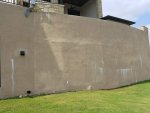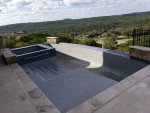Hello!
I have a pool that is a little over 2 years old. It is on a hillside in Austin, TX so the back wall of the pool is about 13' tall. The front side meets up with our back patio and no wall was built on that side. The pool builder originally sprayed gunite on 3 walls with rebar (not the front side against the house foundation). Then they added dirt fill into the structure. Then they built the top layer (which has the pool shell) with just a single mat rebar on the pool bottom (instead of double mat or using piers). We are experiencing cracks along the back and side edges of the pool. There are definitely structural issues due to faulty construction (not built to an engineer's standard). We have consulted with three structural engineers and they all have different opinions. One says to tear it down and start over, one says to get geotechnical engineering opinion, and one says to build piers under it now to fix any structural issues (then we wouldn't have to rely on the fill below and a single layer of rebar to hold the pool up). Our builder is willing to add in 8 piers under the pool to provide the necessary support but we are not 100% positive that is a permanent fix and we are not sure if we will need to get into a lawsuit if we need to tear down our pool and rebuild. The piers would be tied into the existing rebar and the pool would be re-plasters (Pebblesheen) afterwards.
Has anyone else dealt with this? Will piers stabilize the pool structurally and prevent future cracking and leaks?
Thank you for any help and ideas!


I have a pool that is a little over 2 years old. It is on a hillside in Austin, TX so the back wall of the pool is about 13' tall. The front side meets up with our back patio and no wall was built on that side. The pool builder originally sprayed gunite on 3 walls with rebar (not the front side against the house foundation). Then they added dirt fill into the structure. Then they built the top layer (which has the pool shell) with just a single mat rebar on the pool bottom (instead of double mat or using piers). We are experiencing cracks along the back and side edges of the pool. There are definitely structural issues due to faulty construction (not built to an engineer's standard). We have consulted with three structural engineers and they all have different opinions. One says to tear it down and start over, one says to get geotechnical engineering opinion, and one says to build piers under it now to fix any structural issues (then we wouldn't have to rely on the fill below and a single layer of rebar to hold the pool up). Our builder is willing to add in 8 piers under the pool to provide the necessary support but we are not 100% positive that is a permanent fix and we are not sure if we will need to get into a lawsuit if we need to tear down our pool and rebuild. The piers would be tied into the existing rebar and the pool would be re-plasters (Pebblesheen) afterwards.
Has anyone else dealt with this? Will piers stabilize the pool structurally and prevent future cracking and leaks?
Thank you for any help and ideas!




 Sorry it's under such circumstances. It might be tough to get an accurate answer from TFP by just reviewing your situation from our computer screens. We do have tons of various members who work in occupations that may see your post and have some good expert advice. The external dripping markings would seem to be signs of efflorescence and also noted on this thread:
Sorry it's under such circumstances. It might be tough to get an accurate answer from TFP by just reviewing your situation from our computer screens. We do have tons of various members who work in occupations that may see your post and have some good expert advice. The external dripping markings would seem to be signs of efflorescence and also noted on this thread: 